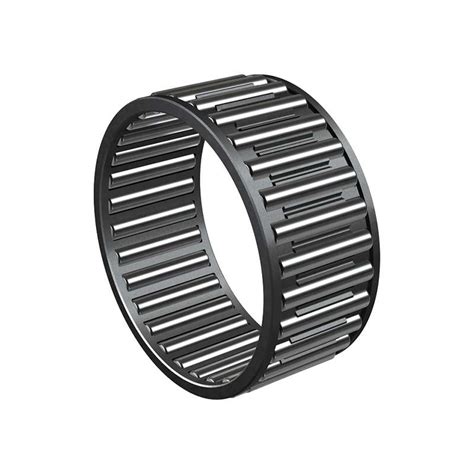The Comprehensive Guide to Needle Roller Bearings
Introduction:
Needle roller bearings are essential components in various industries due to their exceptional characteristics. Their compact size, high capacity, and low friction make them indispensable for applications ranging from automotive and aerospace to industrial machinery. This comprehensive guide delves into the different types, advantages, and applications of needle roller bearings, providing valuable insights for engineers and professionals alike.
Different Types of Needle Roller Bearings:
-
Drawn Cup Needle Roller Bearings: These bearings have a drawn steel cup with needle rollers and a hardened outer surface. They offer high radial load capacity and are ideal for applications with space constraints.

-
Machined Needle Roller Bearings: These bearings are precision-machined with a hardened outer ring, cage, and needle rollers. They provide increased precision and durability for applications requiring high operating speeds or accuracy.
-
Caged Needle Roller Bearings: These bearings have needle rollers retained by a cage, which prevents the rollers from skidding and provides even load distribution. They are commonly used in high-speed applications or where lubrication is not readily available.

-
Thrust Needle Roller Bearings: These bearings are designed to handle axial loads and have parallel races with needle rollers. They offer high thrust capacity and are used in applications such as transmissions and clutches.
Advantages of Needle Roller Bearings:
-
High Radial Load Capacity: Needle rollers distribute the load over a large number of small contact points, resulting in a high load-carrying capacity.
-
Compact Size: Their cylindrical shape and small diameter allow for smaller bearing arrangements, conserving space.
-
Low Friction: Needle rollers have a low rolling resistance, reducing friction and minimizing power loss.
-
High Speed: Properly lubricated needle roller bearings can operate at high speeds without compromising performance.
-
Durability: The hardened steel construction provides long service life and resistance to wear.
Applications of Needle Roller Bearings:
Needle roller bearings are widely used in a variety of applications, including:

-
Automotive: Transmissions, steering systems, engine components
-
Aerospace: Landing gear, flight control systems
-
Industrial Machinery: Machine tools, conveyors, robots
-
Medical Equipment: Surgical instruments, MRI scanners
Common Mistakes to Avoid:
-
Overloading: Exceeding the load capacity of a needle roller bearing can lead to premature failure.
-
Improper Lubrication: Inadequate lubrication can cause excessive wear and reduce bearing life.
-
Incorrect Mounting: Improperly mounted bearings can result in misalignment and reduced performance.
-
Ignoring Wear: Ignoring signs of wear can lead to catastrophic failure. Regular inspection and maintenance are essential.
How to Select Needle Roller Bearings (Step-by-Step Approach):
-
Determine Load Requirements: Calculate the radial and thrust loads that the bearing will experience.
-
Select Bearing Type: Based on the load requirements and application, choose the appropriate type of needle roller bearing (drawn cup, machined, caged, or thrust).
-
Consider Cage Material: Cages can be made of steel, brass, or plastic. Choose a cage material that is suitable for the application and environmental conditions.
-
Specify Inner/Outer Rings: Select the appropriate inner and outer ring diameters and thicknesses based on the shaft and housing dimensions.
-
Consider Lubrication: Determine the appropriate lubrication method and lubricant for the application.
Call to Action:
Needle roller bearings play a crucial role in countless applications, providing exceptional load capacity, durability, and precision. By understanding the different types, advantages, applications, and selection process, engineers and professionals can optimize the performance and reliability of their designs. Embracing the best practices outlined in this guide will ensure the optimal utilization of needle roller bearings in a wide range of industries.
| Bearing Type |
Capacity |
Speed |
Accuracy |
Cage Material |
| Drawn Cup |
High |
Medium |
Standard |
Steel |
| Machined |
Medium |
High |
High |
Brass |
| Caged |
Medium |
High |
Standard |
Plastic |
| Application |
Bearing Type |
Advantages |
Limitations |
| Automotive Transmission |
Caged Needle |
Compact, high capacity |
Sensitivity to misalignment |
| Aerospace Flight Control |
Machined Needle |
High speed, durability |
Higher cost |
| Industrial Machine Tool |
Drawn Cup Needle |
Low friction, space saving |
Limited axial load capacity |
| Mistakes to Avoid |
Consequences |
Preventive Measures |
| Overloading |
Premature failure |
Determine actual load requirements |
| Improper Lubrication |
Excessive wear |
Use appropriate lubricant and lubrication interval |
| Incorrect Mounting |
Misalignment, reduced performance |
Ensure proper alignment and mounting procedures |
| Ignoring Wear |
Catastrophic failure |
Schedule regular inspections and maintenance |

